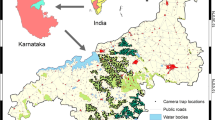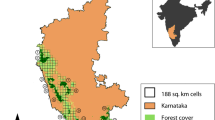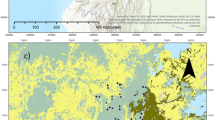Abstract
Conservation decision-making often relies on species’ distribution changes in response to anthropogenic disturbances but overlook their temporal responses. Filling the knowledge gap on the temporal shifts as elusive responses of wild animals to human activity is important because this may provide information for more proactive conservation planning. In this study, we used camera traps in a field survey technique to investigate the trade-offs between spatial and temporal responses of a mammal community to major human activities in Qinling Mountains, China. We focused on five most abundant mammalian species including giant panda (Ailuropoda melanoleuca), takin (Budorcas taxicolor), wild boar (Sus scrofa), tufted deer (Elaphodus cephalophus), and Chinese goral (Naemorhedus griseus), and examined the drivers of, and the trade-offs between the change of their spatial distributions and daily activity patterns in response to anthropogenic disturbances. We found that in response to human interferences, giant panda and takin mainly changed their distributions, while wild boar, tufted deer and Chinese goral altered their daily activity patterns, indicating the elusive responses of the latter species under anthropogenic stressors. In addition, anthropogenic stressors such as farming and tourism have more profound impacts on mammal communities than previously revealed by species distribution modeling only. For nature reserves that aim to conserve multiple species simultaneously, a more flexible, adaptive management framework is thus needed to capture the trade-offs between multiple species’ spatial and temporal responses to anthropogenic disturbance.



Similar content being viewed by others
Data availability
The authors have listed valid sources of all environmental data, and species data is available upon request.
Code availability
Code is available upon request.
References
Bai W, Connor T, Zhang J et al (2018) Long-term distribution and habitat changes of protected wildlife: giant pandas in wolong nature reserve, China. Environ Sci Pollut Res 25:11400–11408
Bearer S, Linderman M, Huang J et al (2008) Effects of fuelwood collection and timber harvesting on giant panda habitat use. Biol Conserv 141:385–393
Bejder L, Samuels A, Whitehead H et al (2009) Impact assessment research: use and misuse of habituation, sensitisation and tolerance in describing wildlife responses to anthropogenic stimuli. Mar Ecol Prog Ser 395:177–185
Benítez-López A, Alkemade R, Verweij PA (2010) The impacts of roads and other infrastructure on mammal and bird populations: a meta-analysis. Biol Conserv 143:1307–1316
Bu H, Wang F, McShea WJ et al (2016) Spatial co-occurrence and activity patterns of mesocarnivores in the temperate forests of Southwest China. PLoS One 11:e0164271
Carter NH, Shrestha BK, Karki JB et al (2012) Coexistence between wildlife and humans at fine spatial scales. Proc Natl Acad Sci 109:15360–15365
Chen W, Wu QG, Hu JC et al (2012) Seasonal habitat use of Chinese goral (Naemorhedus griseus) in a subtropical forest. Russ J Ecol 43:256–260
Díaz-Ruiz F, Caro J, Delibes-Mateos M et al (2016) Drivers of red fox (Vulpes vulpes) daily activity: prey availability, human disturbance or habitat structure? J Zool 298:128–138
Ditchkoff SS, Saalfeld ST, Gibson CJ (2006) Animal behavior in urban ecosystems: modifications due to human-induced stress. Urban Ecosyst 9:5–12
Fischer M, Di Stefano J, Gras P et al (2019) Circadian rhythms enable efficient resource selection in a human-modified landscape. Ecol Evol 9:7509–7527
Fiske I, Chandler R (2011) Unmarked: an R package for fitting hierarchical models of wildlife occurrence and abundance. J Stat Softw 43:1–23
García CB, García J, López Martín MM, Salmerón R (2015) Collinearity: revisiting the variance inflation factor in ridge regression. J Appl Stat 42:648–661
Gaynor KM, Hojnowski CE, Carter NH, Brashares JS (2018) The influence of human disturbance on wildlife nocturnality. Science 360:1232–1235
Gibeau ML, Clevenger AP, Herrero S, Wierzchowski J (2002) Grizzly bear response to human development and activities in the Bow River Watershed, Alberta, Canada. Biol Conserv 103:227–236
Guan T, Wang F, Li S, McShea WJ (2015) Nature reserve requirements for landscape-dependent ungulates: the case of endangered takin (Budorcas taxicolor) in Southwestern China. Biol Conserv 182:63–71
Heinrichs JA, Bender DJ, Schumaker NH (2016) Habitat degradation and loss as key drivers of regional population extinction. Ecol Modell 335:64–73
IUCN (2016) A global standard for the identification of key biodiversity areas, Version 1.0. First edition. IUCN, Gland, Switzerland
Karanth KU, Srivathsa A, Vasudev D et al (2017) Spatio-temporal interactions facilitate large carnivore sympatry across a resource gradient. Proc R Soc B 284:20161860
Kéry M, Chandler R (2012) Dynamic occupancy models in unmarked. Available at http://cran.r-project.org/web/packages/unmarked/vignettes/colext.pdf. Accessed 20 Apr 2015
Kuhn NJ, Yair A, Grubin MK (2004) Spatial distribution of surface properties, runoff generation and landscape development in the zin valley badlands, northern Negev, Israel. Earth Surf Process Landforms 29:1417–1430
Li S, McShea WJ, Wang D et al (2010) The use of infrared-triggered cameras for surveying phasianids in Sichuan Province China. Ibis 152:299–309
Li T, Liu K, Ma LY et al (2016) Evaluation on soil erosion effects driven by land use changes over Danjiang River basin of Qinling Mountain. J Nat Resour 31(4):583–595
Linkie M, Ridout MS (2011) Assessing tiger–prey interactions in Sumatran rainforests. J Zool 284:224–229
Liu F, McShea WJ, Garshelis DL et al (2011) Human-wildlife conflicts influence attitudes but not necessarily behaviors: Factors driving the poaching of bears in China. Biol Conserv 144:538–547
Loucks CJ, Zhi L, Dinerstein E et al (2003) The giant pandas of the Qinling Mountains, China: a case study in designing conservation landscapes for elevational migrants. Conserv Biol 17:558–565
Lu Y, Li Q, Wang Y, Xu P (2019) Planning conservation corridors in mountain areas based on integrated conservation planning models: a case study for a giant panda in the Qionglai Mountains. J Mt Sci 16:2654–2662
Ma Z, Li B, Li W et al (2009) Conflicts between biodiversity conservation and development in a biosphere reserve. J Appl Ecol 46:527–535
MacKenzie DI, Nichols JD, Lachman GB et al (2002) Estimating site occupancy rates when detection probabilities are less than one. Ecology 83:2248–2255
MacKenzie DI, Nichols JD, Seamans ME, Gutiérrez RJ (2009) Modeling species occurrence dynamics with multiple states and imperfect detection. Ecology 90:823–835
Marchand P, Garel M, Bourgoin G et al (2014) Impacts of tourism and hunting on a large herbivore’s spatio-temporal behavior in and around a French protected area. Biol Conserv 177:1–11
Martin JGA, Réale D (2008) Animal temperament and human disturbance: implications for the response of wildlife to tourism. Behav Processes 77:66–72
Michalski F, Peres CA (2007) Disturbance-mediated mammal persistence and abundance-area relationships in Amazonian forest fragments. Conserv Biol 21:1626–1640
Nie Y, Speakman JR, Wu Q et al (2015) Exceptionally low daily energy expenditure in the bamboo-eating giant panda. Science 349:171–174
Nouvellet P, Rasmussen GSA, Macdonald DW, Courchamp F (2012) Noisy clocks and silent sunrises: measurement methods of daily activity pattern. J Zool 286:179–184
O’Brien RM (2007) A caution regarding rules of thumb for variance inflation factors. Qual Quant 41:673–690
O’Rourke E (2014) The reintroduction of the white-tailed sea eagle to Ireland: people and wildlife. Land Use Policy 38:129–137
Oriol-Cotterill A, Macdonald DW, Valeix M et al (2015) Spatiotemporal patterns of lion space use in a human-dominated landscape. Anim Behav 101:27–39
Plante S, Dussault C, Richard JH, Côté SD (2018) Human disturbance effects and cumulative habitat loss in endangered migratory caribou. Biol Conserv 224:129–143
Ridout MS, Linkie M (2009) Estimating overlap of daily activity patterns from camera trap data. J Agric Biol Environ Stat 14:322–337
Riley SPD, Sauvajot RM, Fuller TK et al (2003) Effects of urbanization and habitat fragmentation on bobcats and coyotes in southern California. Conserv Biol 17:566–576
Salmerón Gómez R, García Pérez J, López Martín MDM, García CG (2016) Collinearity diagnostic applied in ridge estimation through the variance inflation factor. J Appl Stat 43:1831–1849
Smith JA, Thomas AC, Levi T et al (2018) Human activity reduces niche partitioning among three widespread mesocarnivores. Oikos 127:890–901
Stankowich T (2008) Ungulate flight responses to human disturbance: a review and meta-analysis. Biol Conserv 141:2159–2173
Swaisgood RR, Wang D, Wei F (2018) Panda downlisted but not out of the woods. Conserv Lett 11:e12355
Thirgood S, Redpath S (2008) Hen harriers and red grouse: science, politics and human–wildlife conflict. J Appl Ecol 45:1550–1554
Thurfjell H, Spong G, Ericsson G (2013) Effects of hunting on wild boar Sus scrofa behaviour. Wildlife Biol 19:87–93
Tian Z, Liu X, Fan Z et al (2019) The next widespread bamboo flowering poses a massive risk to the giant panda. Biol Conserv 234:180–187
Tobler MW, Carrillo-Percastegui SE, Pitman RL et al (2008) An evaluation of camera traps for inventorying large-and medium-sized terrestrial rainforest mammals. Anim Conserv 11:169–178
Tuanmu M-N, Viña A, Winkler JA et al (2013) Climate-change impacts on understorey bamboo species and giant pandas in China’s Qinling Mountains. Nat Clim Chang 3:249–253
Tucker MA, Böhning-Gaese K, Fagan WF et al (2018) Moving in the Anthropocene: global reductions in terrestrial mammalian movements. Science 359:466–469
van Doormaal N, Ohashi H, Koike S, Kaji K (2015) Influence of human activities on the activity patterns of Japanese sika deer (Cervus nippon) and wild boar (Sus scrofa) in Central Japan. Eur J Wildl Res 61:517–527
Virkkala R, Luoto M, Rainio K (2004) Effects of landscape composition on farmland and red-listed birds in boreal agricultural-forest mosaics. Ecography 27:273–284
Wang D, Li S, McShea WJ, Fu L (2006) Use of remote-trip cameras for wildlife surveys and evaluating the effectiveness of conservation activities at a nature reserve in Sichuan Province, China. Environ Manage 38:942–951
Wang X, Xu W, Ouyang Z et al (2008) Application of ecological-niche factor analysis in habitat assessment of giant pandas. Acta Ecol Sin 28:821–828
Wang F, McShea WJ, Wang D et al (2014) Evaluating landscape options for corridor restoration between giant panda reserves. PLoS One 9:e105086
Wang F, McShea WJ, Wang D, Li S (2015) Shared resources between giant panda and sympatric wild and domestic mammals. Biol Conserv 186:319–325
Wang F, McShea WJ, Li S, Wang D (2018) Does one size fit all? A multispecies approach to regional landscape corridor planning. Divers Distrib 24:415–425
Winchell CS, Doherty PF Jr (2008) Using California gnatcatcher to test underlying models in habitat conservation plans. J Wildl Manage 72:1322–1327
Woodroffe R, Frank LG (2005) Lethal control of African lions (Panthera leo): local and regional population impacts. Anim Conserv 8:91–98
Yang J, Zhu G, Jiang J et al (2019) Non-invasive genetic analysis indicates low population connectivity in vulnerable Chinese gorals: concerns for segregated population management. Zool Res 40:439
Yu Z, Fung BCM, Haghighat F et al (2011) A systematic procedure to study the influence of occupant behavior on building energy consumption. Energy Build 43:1409–1417
Zeng Z, Song Y, Zhong W et al (2001) Food habits of golden takin. Chinese J Zool 36:36–44
Zeng Z, Song Y, Ma Y et al (2007) Fauna characteristics and ecological distribution of carnivora and artiodactyla in niubeiliang national nature reserve, China. Front Biol China 2:92–99
Zhang Z, Wei F, Li M et al (2004) Microhabitat separation during winter among sympatric giant pandas, red pandas, and tufted deer: the effects of diet, body size, and energy metabolism. Can J Zool 82:1451–1458
Zhang J, Hull V, Huang J et al (2015) Activity patterns of the giant panda (Ailuropoda melanoleuca). J Mammal 96:1116–1127
Zhang J, Hull V, Ouyang Z et al (2017) Divergent responses of sympatric species to livestock encroachment at fine spatiotemporal scales. Biol Conserv 209:119–129
Funding
The project was supported by the National Natural Science Foundation of China (Grant No. 31971537).
Author information
Authors and Affiliations
Contributions
Conceptualization: FW, YD; methodology: FW, YD, QZ; formal analysis and investigation: YD, QZ, YW, BG, FW; writing—original draft preparation: YD, FW, QZ; writing—review and editing: YD, FW, QZ; funding acquisition: FW; resources: FW.
Corresponding author
Ethics declarations
Conflict of interest
The authors declare that they have no known competing financial interests or personal relationships that could have appeared to influence the work reported in this paper.
Ethical approval
Not applicable. This manuscript is a non-invasive wildlife study that do not require ethical approval.
Consent to participate
Not applicable. This manuscript is a wildlife study that do not involve human participate.
Consent for publication
Written informed consent for publication was obtained from all participants. All authors consent to the publication of this manuscript in the journal of Biodiversity and Conservation.
Additional information
Communicated by Clinton Jenkins.
Publisher's Note
Springer Nature remains neutral with regard to jurisdictional claims in published maps and institutional affiliations.
Rights and permissions
About this article
Cite this article
Diao, Y., Zhao, Q., Weng, Y. et al. Temporal shifts as elusive responses to anthropogenic stressors in a mammal community. Biodivers Conserv 30, 2529–2544 (2021). https://doi.org/10.1007/s10531-021-02208-5
Received:
Revised:
Accepted:
Published:
Issue Date:
DOI: https://doi.org/10.1007/s10531-021-02208-5




